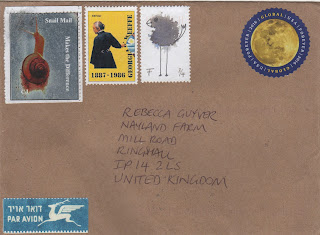One never knows if one's translation of art is in any way what the artist intended, personally I don't think that matters, but sometimes I wonder if I ascribe meaning and intention inaccurately…Having said that, I will comment on this vibrant and unsettling piece by Compass Community Arts with a thumbs up!
Yesterday I saw the Howard Hodgkin portraits at the Portrait Gallery in London. His portraits are emotional responses to situations and people. Although there are recognizeable figurative elements in some, his objective is to create the FEEL of the person or the situation. I think Compass Community Arts is doing the same thing in this postcard, creating the feeling of being in this world where explosions seem to happen more regulalry and touch people they never used to touch.
 |
PORTRAIT OF THE ARTIST, 1984-1987
by Howard Hodgkin |
In our unsettled world, with the fear, prejudice, anger (and so many more emotions and beliefs) we carry around with us, it's good to see someone expressing this in a way that I for one can relate to. This painted, collaged small postcard travelled through the postal system 'unclothed' - without an envelope, speaking to people along the way.
I was interested to Read why Compass Community Arts, who I know throught IUOMA, is involved in mail art:
This is a community Arts project, we meet every week, we are of various ages and backgrounds. Compass started 20 years ago and today we support those with difficulty's such as early Alzheimer', Depression, learning difficulty's and other health conditions that have impacted us physically. With Compass we regain our confidence.
The following sums up my own idea about the role arts organisations can play in society…
'Art plays many roles in society and, at different times, can speak to issues in areas such as religion, science, politics, and history. Whether introducing an international form of movement to the dance scene, putting a modern spin on Mozart or Bach, or providing a visual interpretation of the effects of war, the arts can provide thought-provoking commentary and innovative perspectives on a vast array of global ideas. Arts organizations should, therefore, play the part of illuminator, conveying the power of art in the discourse of complex subjects. In doing so, arts organizations can exist to broaden the horizons of their communities by encouraging analytical thinking and fostering understanding of different opinions and ideas. Moreover, arts organizations can be more participatory in their own communities by bringing art into the public.'
Many thanks Compass Community Arts for getting me thinking after a tiring day getting my garden out of hibernation!



















































